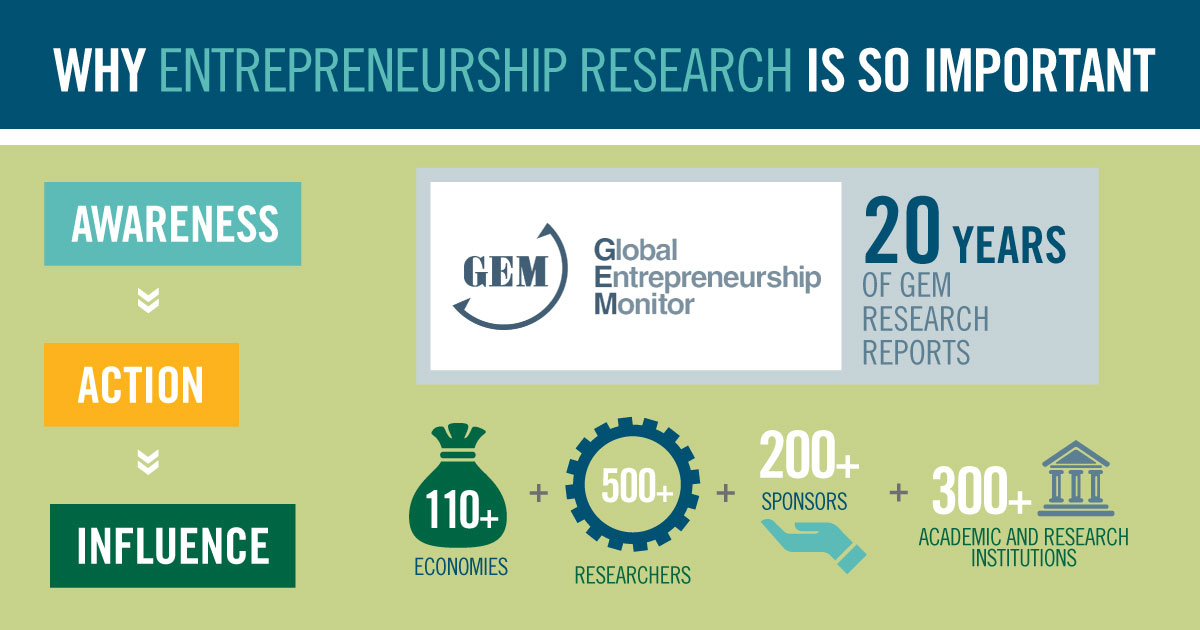Entrepreneurship Research and Why it Matters

This year marks Babson’s Centennial and 100 years of changing how the world does and sees business. Proud to continue to develop and disseminate entrepreneurship research rooted in purpose, Babson is focused on improving entrepreneurial perceptions and opportunity worldwide.
Twenty years ago, Babson College joined the London School of Business to launch the Global Entrepreneurship Monitor (GEM).
The goal of that partnership: to transform the global economy and discourage ingrained economic disparity through action-based research.
Up until recently, the picture of an entrepreneur, for most, was that of a successful young male who launched a tech startup. Babson’s researchers have found that myths and assumptions about entrepreneurship often stir fear of failure or lack of support among those who don’t fit the typical entrepreneur mold.
“While these are certainly people to be celebrated, they don’t account for the diversity of entrepreneurs, including women, older generations, those of different ethnicities, and they also don’t account for the many forms entrepreneurship can take—such as within organizations or family businesses, and as part of a social enterprise,” said Donna Kelley, Babson College professor and co-author of the 2018 GEM Global Report.
She adds, “GEM provides evidence-based data to test, and often refute, our assumptions about entrepreneurs. Through GEM, we can obtain a broader picture of what entrepreneurship looks like around the world, and influence national and global approaches to fostering entrepreneurial ecosystems.”
Findings from 2018 Entrepreneurship Research
Nearly one in five entrepreneurs starts a business that will be owned and/or managed with family members—this according to the 2018/2019 Global Entrepreneurship Monitor (GEM) Global Report(pdf), sponsored by Babson College, Universidad Del Desarrollo, and Korea Entrepreneurship Foundation.*
“It might not be a surprise that many businesses are family-owned, particularly when we see them every day in our communities and read about large family-owned corporations in the news,” said Kelley. “But to our knowledge, this is the first global study of family involvement in the startup phase. The results illustrate the extent to which entrepreneurs rely on family members to get their businesses off the ground.”
Overall, high rates of Total early-stage Entrepreneurial Activity (TEA) can be seen across all income levels.
“Entrepreneurship rates are often high in low-income countries, due in part to fewer job options, but also because there are opportunities to address unmet needs in less competitive markets,” added Kelley.
Additionally, 6 percent of adults across 27 countries are part of the gig and sharing economies. The highest rate of involvement in such activities is in the Republic of Korea at more than 20 percent.
Seventy-five percent of adults in the Netherlands, Poland, and Sweden report that it is easy to start a business in their countries—the highest of all economies studied.
Entrepreneurship among employees of existing organizations is also most prevalent in Europe. In Sweden, Germany, and Cyprus, entrepreneurship is at least as likely to occur in organizations as in independent startups.
Furthermore, the highest proportions of entrepreneurs projecting to create six or more jobs in the next five years are in the United Arab Emirates and Colombia. Both report that more than 50 percent of entrepreneurs have these expectations.
The most noticeable industry trend in the movement from low- to high-income groups is the decline in retail activity. In every low-income economy, retail businesses account for more than half of their entrepreneurs, while only four of the 31 high-income economies report this level. In contrasting high-income economies, 20 percent or more of the startup activity is in finance, real estate, and other business services.
Among various reasons cited for discontinuing a business, the most common was a lack of either profitability or capital, accounting for an average of 45 percent of exits.** In most cases, discontinuance follows TEA. This means that when TEA rates are high, so is discontinuance, and when TEA rates are low, the same can be said about discontinuance.
Entrepreneurial intentions are higher than TEA in every economy in Latin America and the Caribbean, in the Middle East and Africa, and, with the exception of Japan, in East and South Asia. The largest gap in these indicators across the entire sample is found in Morocco and Egypt, where for every person starting a business, six intend to start in the next three years.
This year, GEM introduced the National Entrepreneurship Context Index (NECI), which assesses the environment for entrepreneurship in an economy. The results represent an inaugural effort to inform policy, practitioner, and other key stakeholder audiences about the strength of their overall environment for entrepreneurship. Qatar, a high-income country in the Middle East, receives the highest ranking, following by Indonesia and the Netherlands. An examination of the top-ranked economies illustrates the importance of having healthy conditions across all aspects of the environment affecting entrepreneurship.
This 20th anniversary report profiles 49 economies with respect to demographics, their potential impact, the diversity of forms they take, and their longer-term sustainability. A look back at 20 years shows how entrepreneurship has evolved over time in five countries (the United States, Brazil, Germany, Iran, and China). Finally, the report looks outward at the environment for entrepreneurship, reporting on societal attitudes, self-perceptions, and entrepreneurial affiliations, and then introducing the NECI, which ranks economies based on 12 indicators of the external context that can influence entrepreneurship.






